The objects described in this article comprise the main part of an exhibition that was shown to invited guests of the Museum on April 26th last. Since then they have remained on exhibition, under temporary conditions, on the main floor of the University Museum.
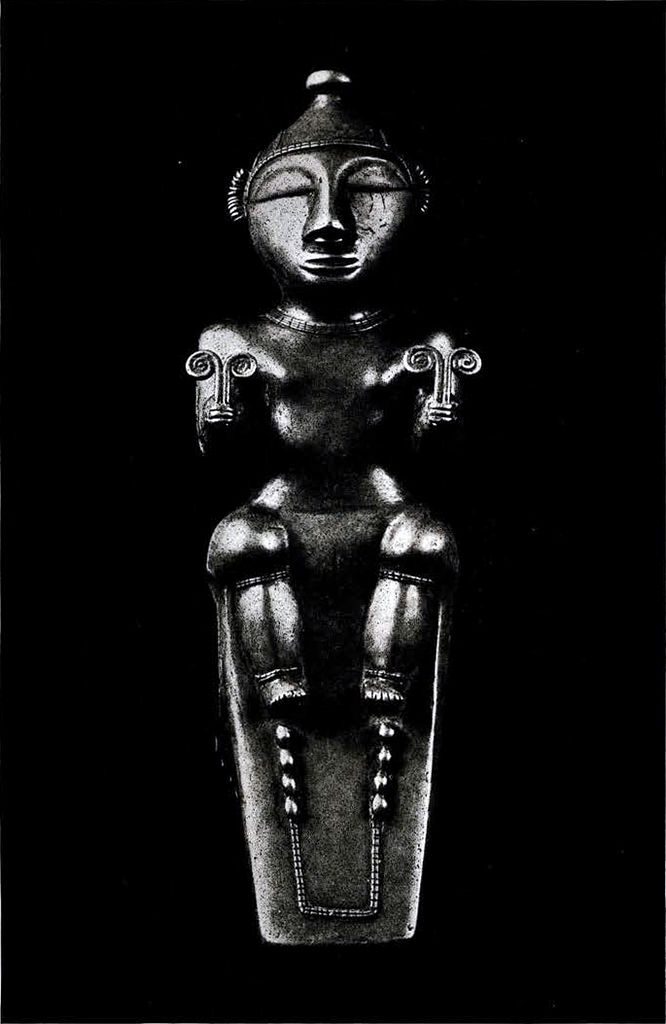
Museum Object Number: SA2751
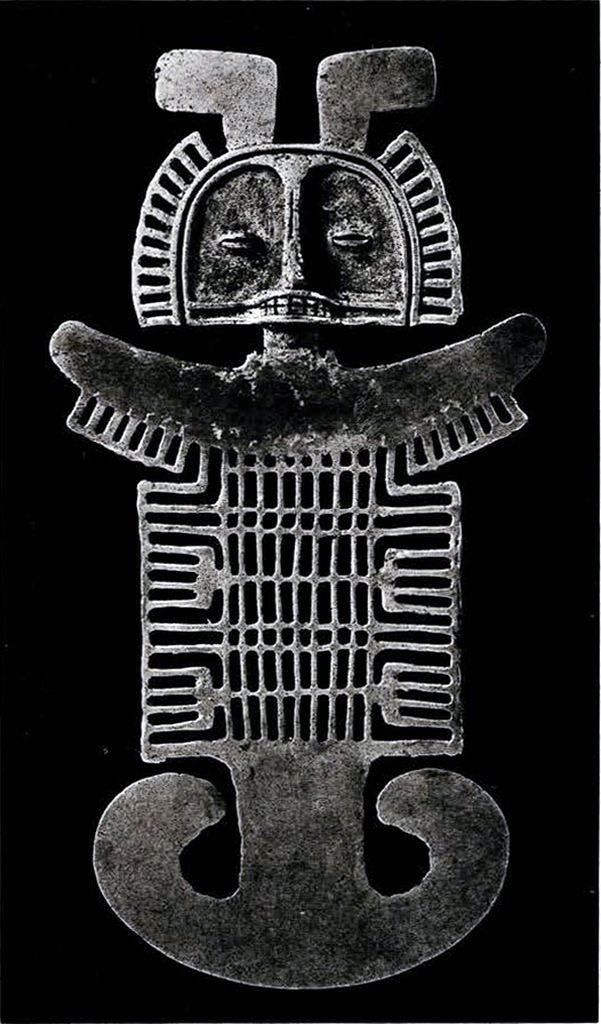
Museum Object Number: SA2753
This exhibition, the first one of the kind that the Museum has ever shown, consists in its greater part of two collections recently acquired. The first of these was bought in Paris in the latter part of 1919 and the other was acquired in the early part of 1920. The Paris collection represents all of the ancient American gold-working civilizations from Mexico to Peru. The other collection consists of a group of objects recently excavated in the mountains near Ayapel, Antioquia, Colombia, where they had been deposited in some remote time by the Indians who produced them. This is the greatest discovery of buried treasure that has taken place in South America since the days of the Conquest.
At the time of the discovery of America the native peoples from Mexico to Peru had achieved remarkable results in metal working, particularly in the manufacture of objects of gold. It may be said in truth that the inhabitants were living in a golden age. No other people ever used the precious metal so lavishly as did the first Americans. The Spanish conquerors give glorious accounts of the splendor of the age which they so soon brought to an ignominious end.
Thirst for geographical knowledge may have inspired Columbus to set out on his voyage of discovery but certainly greed for gold was the inspiration for the conquest which followed. Cortez told the plain truth to Montezuma, as he afterwards learned to his sorrow, when he said that the Spaniards were suffering from a disease which only gold could cure. Montezuma sent supplies of the yellow metal to alleviate their suffering only to discover that the disease was really incurable. Gold has ever been interwoven with human history but nowhere have the results of gold seeking been so disastrous to all concerned as in the Spanish conquest of America. The possessors together with their superior culture were immediately destroyed while the dispossessors and their government were debauched and immediately began to degenerate.
The Lucayos, who were the first to greet Columbus upon his arrival in the New World, were wearing gold ornaments which at once attracted the attention of Columbus and his followers. They lost no time in exploring the islands for other wealth but hurried about from island to island following the imperfectly understood directions of the Indians, seeking only golden treasure which for a time eluded them. In Cuba and San Domingo larger amounts were found but it was not until they reached the mainland in Central America, Mexico and Peru that enormous quantities were secured. Some of the first accounts are interesting. When Columbus arrived at the Bay of Cerebaro he found the natives “wearing neck ornaments of base gold in the form of eagles, lions and other beasts and fowls.” His men took from the house of a chief “gold plates, little eagles, small quills which they string and wear around their legs and arms and gold twists they put about their heads in the nature of a coronet.” They met men wearing gold plates suspended from their noses. On the west coast gold was collected in the shape of bracelets, collars, earrings, breastplates, helmets and “certaine barres wherewith women bear up their breasts.” It is estimated that the ancient cemetery near Bugaba, Costa Rica, has yielded $50,000 worth of gold objects in the form of birds, frogs, fish, alligators and numerous anthropomorphic forms with human and animal elements combined, the most common being the human body with the head of an alligator, jaguar or parrot.
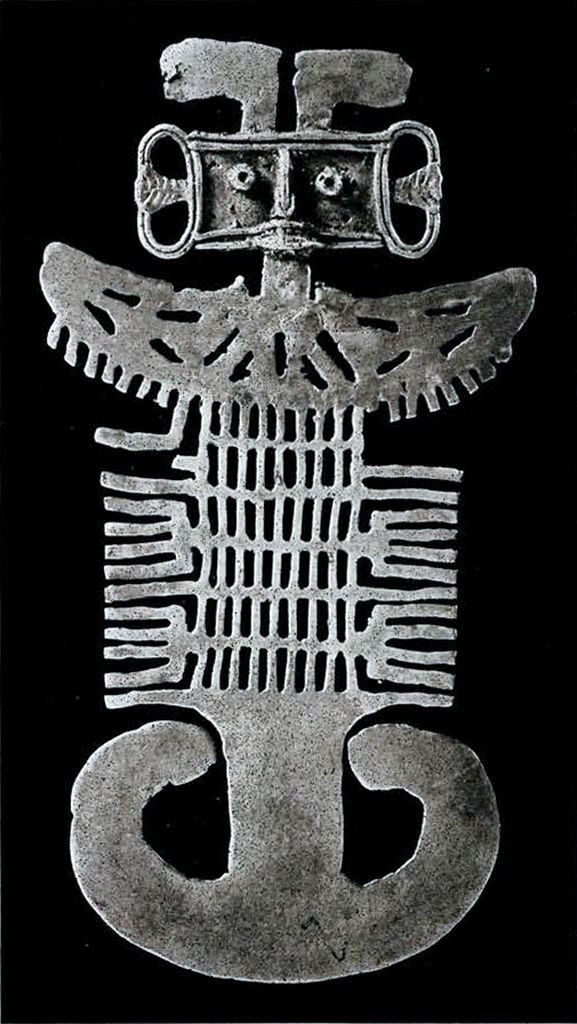
Museum Object Number: SA2754
Image Number: 20320

Museum Object Number: SA2762
Image Number: 20314
When Cortez arrived on the coast of Mexico he sent greetings to the Aztec King. In replying Montezuma made one fatal blunder. He recommended Cortez to return whence he came but at the same time he gave him among other presents a “huge gold plate large as a carriage wheel, representing the images of the sun and moon and engraved with figures of animals”—Cortez accepted the presents, sent the gold plate valued at $25,000 to Spain, destroyed his ships to prevent disaffection among his followers and set out to conquer Mexico. When, after much tribulation, he finally arrived, he found Montezuma sitting in his royal litter glistening with polished gold. The King was seized and his treasure valued at $7,500,000 confiscated, but it was not all carried away. When the Spaniards were compelled to flee, Cortez opened the treasure and told his men to help themselves, but to remember that gold is heavy. In the fighting that followed many of his warriors lost their lives because their pockets were too heavy with gold.
On that eventful day in 1513 when Balboa beheld the Pacific from a mountain peak in Darien, he learned of a great empire to the southward where gold was a household metal. Where “pots and pans and kitchen utensils were of gold and plate” and the people valued it not. Balboa was engaged in weighing 4,000 ounces of wrought gold which had been given him by an old chief when the chief’s son contemptuously overturned the scales, saying that if he took so much interest in such a small amount he should go south where the people had ships with sails and oars; there he would find sufficient gold to satisfy his desires. Later, on the Pacific coast, a chief told Balboa the country far to the south was rich in gold, that the people used domestic animals to carry burdens. He made a model of the animal in clay and the Spaniards thought it must be a camel.
Balboa decided to build some ships and go in search of these marvelous people who were so highly civilized. He sent to Cuba for materials which were landed at Ada and carried across the mountains to the Pacific where the ships were built. It was a most difficult undertaking. No one else could have accomplished the task, and he succeeded only because the chief, whose daughter he had taken as his wife, furnished men and supplies. At last four small vessels were completed and three hundred men were ready to depart, when Balboa was called back to Ada for final instructions. As he approached the village he was met by Francisco Pizarro who put him in chains and carried him to the Governor’s quarters where false charges were made against him and he was beheaded over the trunk of a tree. Thus that monster of cruelty, Pizarro, proved himself a base traitor to his old friend and benefactor.
The death of Balboa at this time was a great calamity for South America. He was humane and judicious, one of the few men of high character among the Conquistadores. He was a natural leader of men. He had saved the starving colony at Darien by winning the confidence of the Indians. He took constant care to prevent the natives from being ill-treated and robbed. The Conquest of Peru would have been a very different story from that which took place under the heartless, unprincipled Pizarro a few years later.
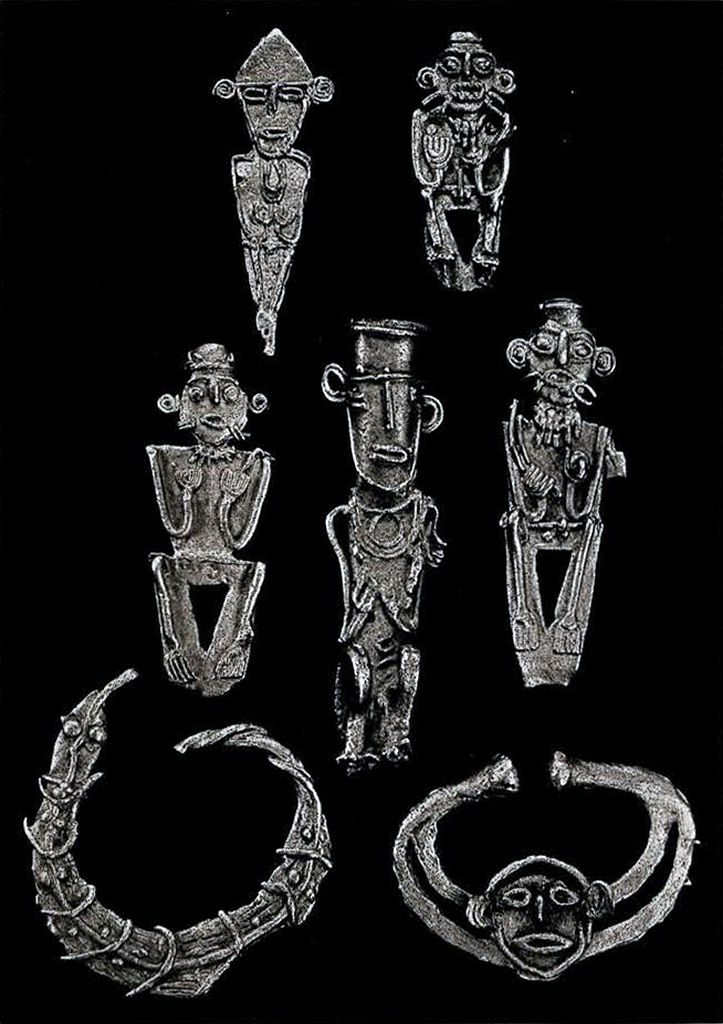
Museum Object Numbers, From Top Left: SA2823 / SA2825 / SA2822 / SA2821 / SA2804 / SA2802
Image Number: 20321a, 20321b
On May 16, 1532, Pizarro came to the river Chira in Peru “where he burnt two chiefs and some other Indians” and founded his town of San Miguel. He reached Caxamarca November 15th and the next evening treacherously massacred some two thousand Indians without the loss of a single man and captured the Inca King. Learning of Pizarro’s love for gold, the Inca offered to fill the room in which he was confined with pure gold as a ransom for his freedom. The offer was accepted and the gold soon began to pour in from all directions. When the room had been filled to the height a man could reach, the cupidity of the Spaniards could stand the strain no longer. The gold, valued at ten or fifteen million dollars, was seized and divided among the leaders and the men in proportion to their stations. The Royal fifth was sent to Spain under the care of Pizarro’s brother. But the Inca, his ransom paid, was not released; he was tied to the stake and given his option of being burnt alive as a heathen or strangled to death as a Christian. Whether or not he made a sign is a question, at any rate, he was baptized and suddenly strangled with a bow string.
In the meantime Pizarro had sent a brother to Pachacamac where he stripped the temple of twenty-seven loads of gold but he was unable to find the four hundred loads which the chief had previously sent away for safety. When the news of the Inca’s murder reached the pack trains bearing additional gold for his ransom, the men turned aside with their treasures and hid them away from the Spaniards. The two hundred Indians, carrying the great gold chain which had encircled the plaza at Cuzco, threw it into a lake where, no doubt, it rests intact today. All told, the Spaniards secured many millions of dollars worth of golden objects but many more millions escaped them. The search for this buried treasure has continued to the present time and will continue for generations to come.
Much of the ransom gold came from the sacred temples, and the accounts given by some of the Spanish superintendents of the collecting, give us some idea of the splendor of those religious centers. At Cuzco, the temple occupied one whole side of the great court. The cornice of the walls, a yard wide, outside and in was plated with gold as were the inner walls also. At the eastern end a great plate of gold, representing the sun, spread from one wall to the other. This great image was not taken for the ransom but when the Spaniards afterwards returned to Cuzco, it had disappeared and was never found. Ranged beneath this sacred symbol on golden thrones, dressed in their royal robes, sat the desiccated remains of the Inca rulers. The High Priest wore a grand tiara which included a circular plate of gold representing the sun and a half-moon of silver. His headdress was adorned with feathers of the macaw and covered with gold and jewels. His loose sleeveless tunic reached to the ground. Over it there was a shorter garment of white wool trimmed with red which came to his knees and was covered with plates of gold and precious stones. On his arms he wore bracelets of gold and on his feet, shoes of finest wool.
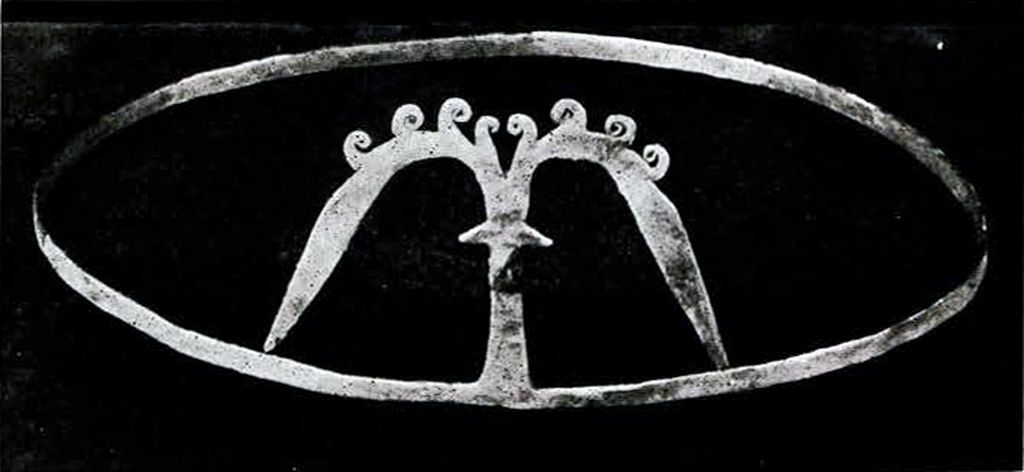
Besides the worship of the sun the Incas had special personal deities in whom they placed great confidence. They were in the form of animals or birds some of which were of large size. That of Pachacuti was sent in pieces for the ransom. Each member of the royal family had his special deity which he called “brother. ” These were always buried with their owner. Some were found by the Spaniards but that of Huayua Ccapac, a golden image of great value, was never found, although much sought after by the Spaniards. The story of Pent is already familiar. Let us return to the Isthmus.
Pedro de Heredia obtained a concession on the coast from the Magdalena river to Darien. He was a native of Madrid. In his wild youth he had his nose slit in a street brawl and revenged himself so outrageously that he fled for safety to San Domingo where he inherited a large estate from a relative. He brought to the colony with him as his lieutenant Francisco Cesar. They arrived at Cartagena January 14, 1533, with fifty men and twenty horses. Heredia brought with him an Indian girl who had been carried off to San Domingo where she learned Spanish so that she could act as an interpreter. Through her influence, Heredia made peace with the neighboring chiefs from whom he secured supplies. From his first conquering expedition into the interior he brought back gold amounting to $3,000,000 worth and a massive figure of gold from a temple, weighing one hundred and twenty-five pounds. He found the great cemeteries of Zenu. He made other successful expeditions. It was believed that he concealed a great deal of the gold he found and he was thrown into prison but later exonerated. The ship in which he took passage for Spain was wrecked at sea.
Vadillo, the officer who threw Heredia into prison and robbed him of his treasure, apprehensive of his own safety, decided to undertake some discovery. He took with him Cesar, who had headed an expedition which crossed the Abibe mountains and returned with $90,000 worth of gold taken from the tombs. They crossed the mountains and attacked the chief, Nutibara who, carried in a litter, richly inlaid with gold, commanded his warriors in person. He was defeated and Vadillo moved on to the Nori valley where the chief, Nabuco, to get rid of him, presented him with gold, at the same time telling him he would find more in the next valley. The Spaniards pushed on and captured some of the entrenched natives, among them the wife of the chief, Buritica. The chief surrendered himself as a ransom for his wife. He and his family had some gold, and upon his refusal to reveal the whereabouts of his treasure Vadillo burned him alive. Leon says, “The detestation we conceived for these Indians was such that we hung them and their women by their hair to the boughs of trees; and left their bodies there, whilst amid grievous moans their souls went down to hell.” Soon afterwards Cesar died and the expedition broke up. Vadillo had discovered the great valley of the Cauca which contained the richest gold mines of the whole region, but, he was a fugitive from justice. He was sent to Spain and died in poverty.

Museum Object Number: SA2763
Image Number: 20317
About the end of 1530, some merchants of Augsburg secured from Charles V permission to make settlements in Venezuela. A German, Alfinger by name, was sent out as the first Governor of a colony which was established at Coro. He soon found that the country round about was too barren to support a colony, so he turned his attention to the westward. He crossed the divide and descended the Cesar river to the Magdalena and succeeded in obtaining some $60,000 worth of gold objects. He impressed into his service several hundred native porters. To prevent their escape they were chained together in a long line, each man with a ring around his neck attached to the chain. They suffered terribly from the hardships of the journey and the cold of the mountains. When one was too sick or too weak from exhaustion to keep up with his companions, there was no time to unfasten the ring from his neck, so Alfinger’s trusted servant cut off the poor fellow’s head and let his body drop out by the wayside. Only a German could outdo the Spaniards in perpetrating horrible practices upon the helpless natives. Three hundred naked packers died from cold in the Cachiri mountains. The natives continued the defense of their homes. Many of Alfinger’s men were killed, his butcher servant among them, and he himself was wounded in the neck. He attempted a retreat but died from his wounds on the third day. Many of his men died of hunger, others killed and ate their Indian porters, a few reached a river where they found some natives who took pity on them and gave them food. The fiends stabbed to death the man who brought them food and seized his canoe. Three years later they reached Coro. The other German expeditions in search of El Dorado do not interest us here.
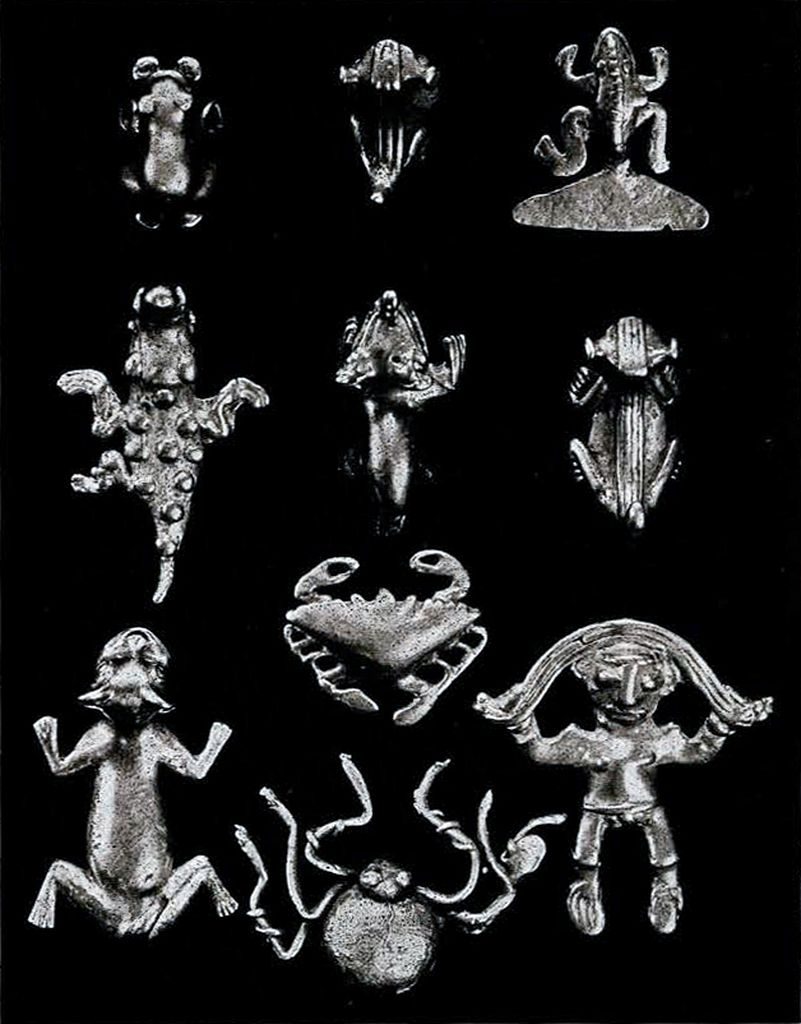
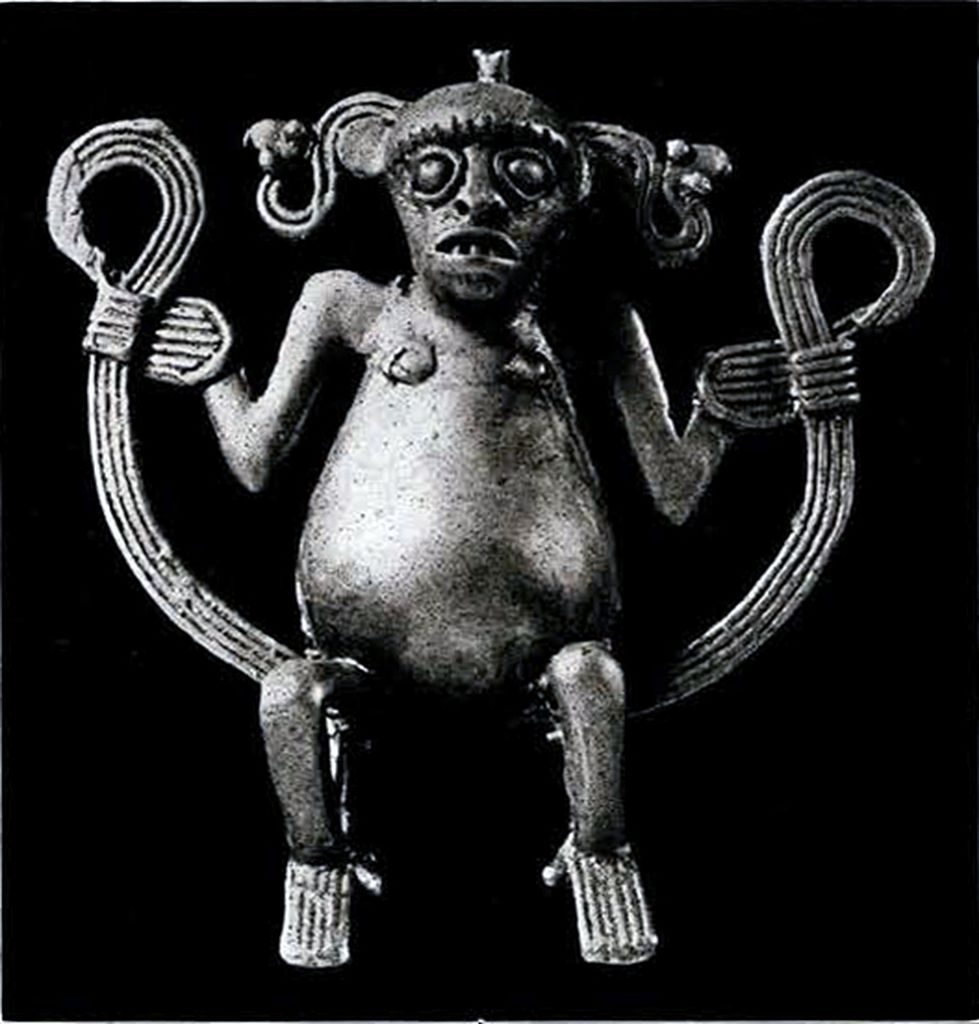
Museum Object Number: SA2781
We must go to Southern Spain for a glimpse of the early life of our next Conquistador. An ill-tempered boy was driving a heavily laden donkey along a muddy country lane. The donkey could make slow progress through the deep mire. In his impatience the pitiless rascal beat the donkey to death. Now this happened to be the family donkey and the boy’s father was a very poor peasant. Afraid to go home, the boy ran away to Seville. Later on he learned of an expedition sailing for Darien and offered himself as a soldier. When questioned, he said his name was Sebastian, that he came from Belalcazar, but he did not know his family name. So Sebastian de Belalcazar enlisted and sailed for the New World. He served at Darien and in Nicaragua. He joined the expedition to Peru and was sent by Pizarro to conquer Quito with 140 men. He carried out his orders but he was ambitious, ungrateful and unfaithful. He set out to find a dominion for himself. In 1536 he appeared on the plateau of Popayan in Colombia. The Indians defended their homes with desperation but he practiced such cruelties upon them that they fled to the mountains. He extended his raids down the valley of the Cauca and founded the town of Cali. His cruelties nearly exterminated the population of the whole region. Those remaining refused to plant their crops and famine ensued. Satisfied with his work, Sebastian de Belalcazar set out for Spain in 1539 to obtain a concession as a Governor independent of Pizarro. He ceased to correspond with or to acknowledge his debt of gratitude to Pizarro, his chief, to whom he owed his position. He went to Spain, received his concession and returned. Robledo received a concession adjoining that of Sebastian but when he came with a few men to occupy it, Sebastian with a large force attacked his camp at night, captured Robledo, his old friend, and put him to death by hanging. For this treachery Sebastian was condemned to death and ordered to Spain, but he died on the way in 1550.
The territory Sebastian de Belalcazar ravaged was that occupied by the Quimbaya, the race of goldsmiths. They produced no gold themselves but obtained it from the tribes to the northward in exchange for salt and manufactured articles. The Spaniards reported them as the best goldsmiths in Granada and a Chibcha legend confirms the story of their former reputation. Their smiths were in such demand by other tribes that their chief required two men in exchange for one of his smiths. A Chibcha chief, who greatly desired to get possession of the Quimbaya territory, hit upon a novel strategy. From time to time, as he had need for goldsmiths, he sent two of his trusted warriors for each smith until finally he had thus planted a sufficient number to effect the capture of the chief and his beautiful plateau country. Sebastian used more direct methods, he destroyed the population and took possession of the country.
Among the Quimbaya only those of high rank, the chiefs, priests and war leaders, were allowed to wear objects of gold. The bodies of the chiefs were cremated and their ashes deposited at the bottom of deep graves in golden urns over which were buried the bodies of their wives. The chiefs wore cotton garments ornamented with gold plates. The doors of the palisades were hung with plates of gold which gleamed in the sun and clashed melodiously in the wind. The gold plates from the door of Sogamoso palace were valued at $80,000. The amount of gold carried away by Sebastian is not recorded.

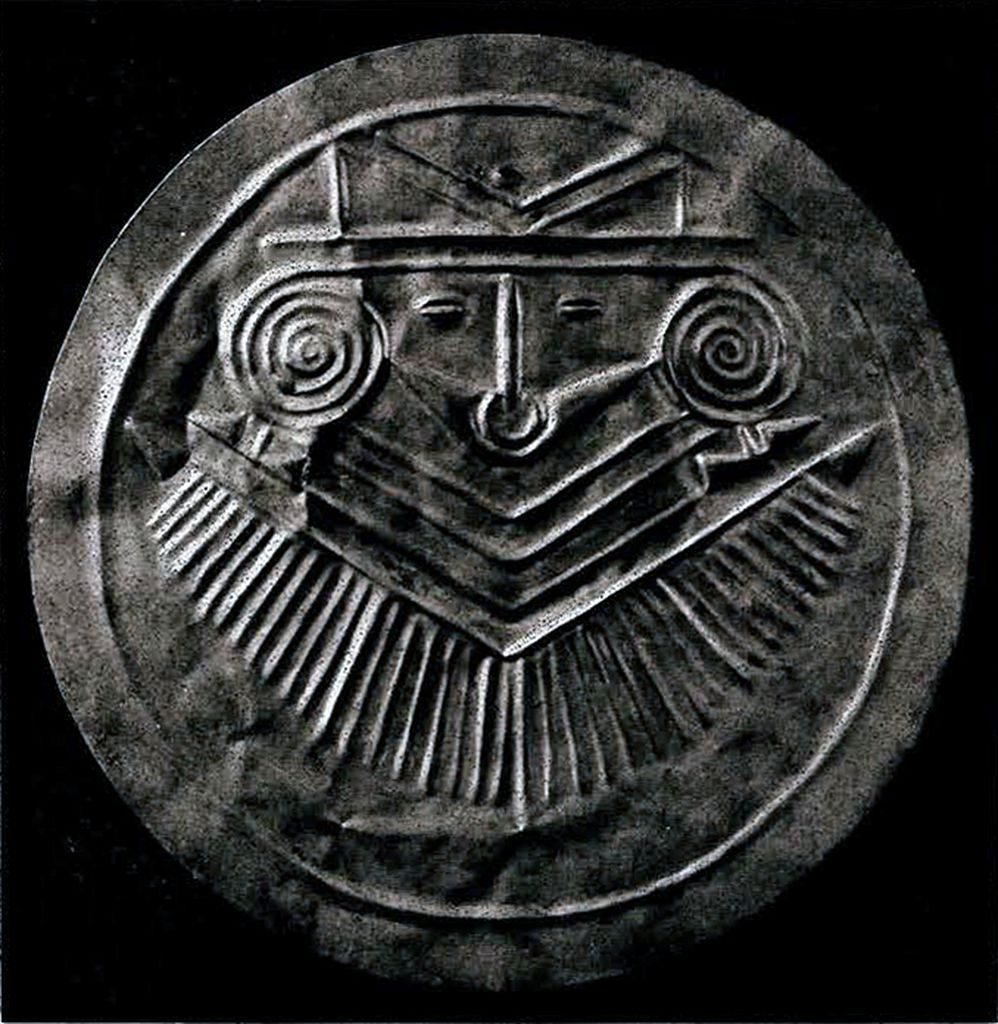
Museum Object Number: SA2756
Image Number: 20313
We must return to the Caribbean, for the conquest of New Granada proper took place from the north coast. Quesada, the destined destroyer of the highly developed Chibcha civilization, was a cultured, educated lawyer at the High Court of Justice at Granada when he received an appointment as chief magistrate of the new province of Santa Marta on the Magdalena river. In company with the new Governor, Pedro Lugo, he landed at his post in December, 1535. The Indians were hostile and food was scarce. Lugo set out to secure gold and provisions. He captured an Indian village but finding nothing, he returned with the sick and wounded while his son Luis continued along the coast. The son was successful in securing large amounts of gold and provisions, but instead of returning to the relief of his father and his destitute friends, he hailed a passing ship, went on board with all the gold and sailed for Spain.
The Governor was overcome with grief at the infamy of his son. He was in great difficulty and resolved to send out an exploring expedition to find the source of the Magdalena in the hope that the rich and fertile provinces which had been reported might be discovered. For his leader he selected Quesada, who started out on April 6, 1536, with 600 soldiers and 100 horses accompanied by five large boats manned by 200 sailors. The men were encouraged by the knowledge that great quantities of gold had been secured from the cemeteries of Zenu by their neighbors of Cartagena. When Quesada arrived at the confluence of the Cesari river, where he had planned to meet the boats, he learned that the fleet had met with disaster. Three of his best boats had been lost but others had been secured and were on their way. Quesada had lost a hundred men and many more were sick. When the boats arrived the sick were put aboard at once and the journey continued up river. A trail was cut through the thick forest for the men and horses. Mosquitoes, ants and other insects tormented man and beast. Many died in the forest. For a month they saw no natives or signs of cultivation. A hundred more men had died. The two oldest and most experienced officers advised Quesada to return, saying that the whole party was of one mind. Quesada told them that to retreat would be more fatal than to advance, that their Governor had spent his fortune on the expedition, that he would not abandon the undertaking and that he would hold as his enemy anyone who proposed such a course. For the first time in his life Quesada armed himself. The captains submitted and a new start was made.
A reconnoitering party which was sent out soon returned, having discovered cultivated districts in the interior. The boats were ordered to return to Santa Marta with the sick and to bring back reinforcements. The officer in charge had orders not to molest the natives, but he soon began to kill and plunder the people of the villages along the river. Finally the natives united in defense and three boats filled with the sick were sunk, only one escaped. Quesada himself treated the Indians along the way with consideration; he even executed a soldier for robbery. From his later conduct we may judge these acts of justice as matters of policy only. Quesada with only 200 men and 60 horses began the ascent of the Opon mountains, 6,500 feet in elevation. The cold was intense. Thirty- four men and one horse perished on the way. We can hardly imagine the joy of the survivors when from the summit of the mountain they looked out upon a vast cultivated plain dotted with lakes and villages—the “valley of palaces.” They were the first to behold the “Chibcha Empire” with all its wealth of culture and gold. More than forty years had passed since Columbus met the original Americans. The West Indies, Mexico, Central America, Darien, Peru, Ecuador and Cartagena had been devastated, the natives murdered or robbed and enslaved. But the Chibchas in their splendid isolation knew nothing more than vague rumors of what was going on about them and were happy in their seclusion and prosperity. Had they seen the small dark cloud gathering on the top of Opon, they could not have comprehended its evil foreboding.

Museum Object Numbers, From Top: SA2798 / Unknown / SA2792 / SA2793 / Unknown / Unknown / Unknown / Unknown / Unknown / Unknown / SA2801
Image Number: 20322
Quesada immediately pushed on and attacked the chief of Suesca. The Zipa, the name applied to the Chibcha ruler, was in his palace at Muequeta when he received a messenger from Suesca who told him of the sudden appearance of strange men and animals, terrible and irresistible. The Zipa, with several hundred warriors, set out to meet the invader in person. The army in the field was “a fine spectacle. The mummy of the former Zipa was carried in front of the army. The Zipa himself was borne on the shoulders of his attendants in the royal litter richly inlaid and decorated with gold and emeralds. The war chiefs wore feather helmets set in gold and emeralds with gold crescents on their foreheads, gold nose and ear ornaments, great bracelets, collars, breastplates and shields all of solid gold. The soldiers were armed with spears and swords of hardwood; slings and spear-throwers. A few used bows and arrows but without poison. There was a brief engagement, in which the Spanish cavalry inflicted fearful slaughter. The Zipa, convinced that defense was useless and his country doomed, decided to retire to some secret place from which he could direct operations, in the hope that some terms might be made with the enemy. He sent messengers with presents to arrange for an interview and thus delayed Quesada until he could perfect his own arrangements and send away his treasures. Quesada captured the palace at Chia but the heir apparent fled after concealing his treasure which was never discovered. The Spaniards, provoked, hurried on to capture the Zipa’s palace at Muequeta where they expected to find a great store of gold. After severe fighting the palace was taken but the Zipa with his treasure had escaped.
The thirst for gold was unsatisfied. Exploring parties were sent out which met with determined resistence in the north and west and secured no gold—nothing but a few emeralds. Then in desperation Quesada rushed to the east to take the chief of Tunja by surprise before he could conceal his treasure. The chief, an old man, had heard of the butcheries of the Spaniards and had resolved upon conciliation as the only hope of humane treatment. So, when Quesada appeared, he sent presents and asked him to wait outside the palace until preparation could be made for his reception, but Quesada and his villains forced their way through a defenseless crowd and broke into the palace. They found the chief seated on his throne. When asked concerning his treasure he made no reply. Upon being urged and threatened, he said “my body is in your hands but you cannot command my will.” He was seized, put in chains and died of a broken heart a few days later. His palace was looted and the contents heaped in the courtyard. Besides the rich cotton cloth matting and other decorations there were some $600,000 worth of gold and silver and 1,815 emeralds. This was the only large treasure secured by Quesada. He never learned the secret burial place of the Zipas. The body of the Zipa was embalmed and buried in the trunk of a tree lined with gold. Subchiefs were buried in cemeteries with their jewels and great amounts of gold. One cemetery yielded $2,500 in gold. In one palace the Spaniards found an urn of gold set with jewels weighing 437½ ounces.
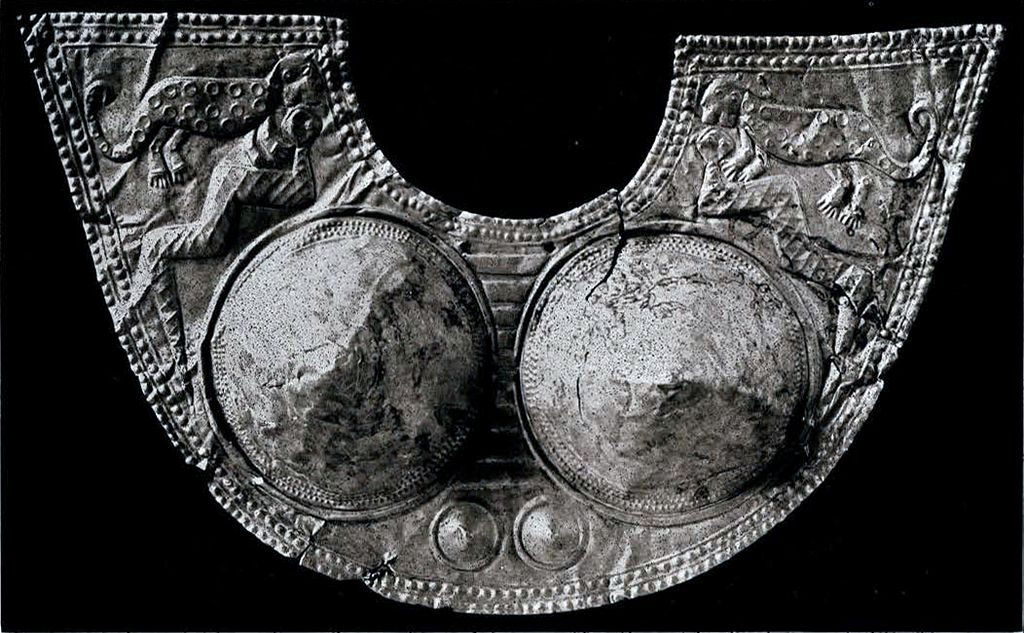
Museum Object Number: SA2703
Image Number: 2029
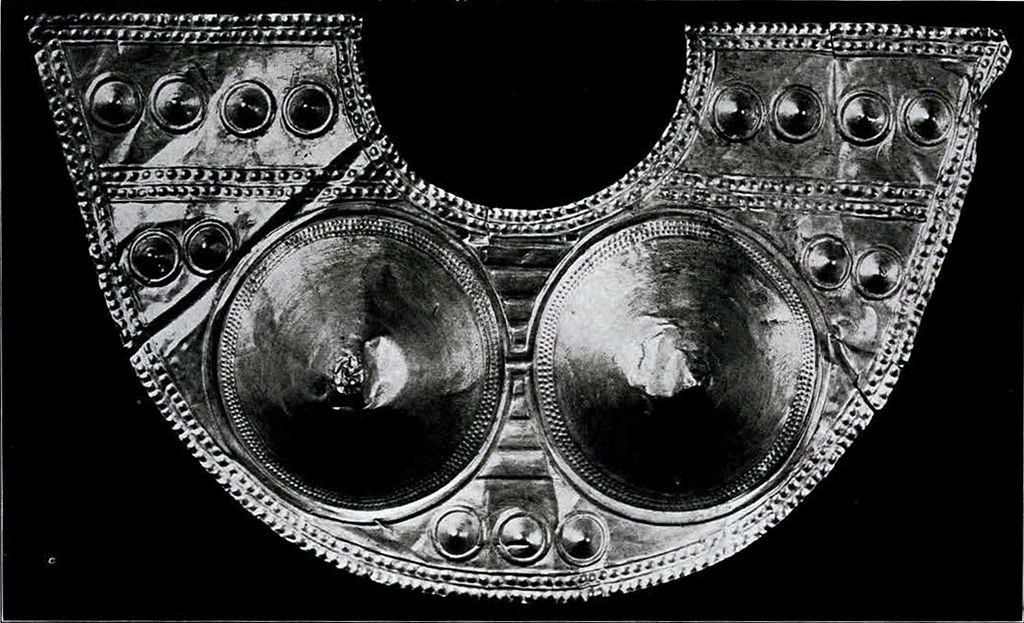
Museum Object Number: SA2702
Image Number: 20298
At Tunja, the Spaniards heard of the palace of the Iraca, the religious chief located at Suamo, the most sacred place in the Chibcha country, twenty miles away and rushed off to despoil the temple. They broke down the doors and found a single old priest guarding the sacred place. They saw behind him the mummies of the holy men adorned with plates of gold. While the Spaniards hesitated, flames broke out and the temple, its treasures and its guardian priest were consumed before their eyes. What a glorious end! The Chibcha civilization thus disappeared. This was the last stronghold.
Quesada took up his headquarters in the palace of the Zipa at Muequeta and distributed his plunder among his followers. But the amount for each was small, no one was satisfied; so new sources were sought. They learned where the Zipa was in hiding and attacked him at night hoping to find his treasure. The Zipa was mortally wounded but his followers soon rallied and put the Spaniards to flight. The Panches, old enemies of the Chibchas, began to raid the Chibcha country. The old Zipa had died. The new Zipa went to Quesada with gold and emeralds to ask for assistance against his enemies. An agreement was made and the Panches were defeated. But the Zipa had made a fatal mistake. Pizarro had held the Inca King for a ransom. Why not try the same tactics on the Zipa? He was their guest. He had entered their camp on promise of safe conduct. But the fiends wanted gold. The Zipa was put in chains. He told them that the treasure had been divided among the chiefs when the old Zipa fled from Muequeta. He was kept alive and tortured for many days but finally died in great agony without saying another word. He had told them the truth. One can hardly believe that this awful crime was perpetrated by that cultured gentleman who, a year before, was so jealous of Spanish honor that he executed a soldier for robbing a helpless Indian.
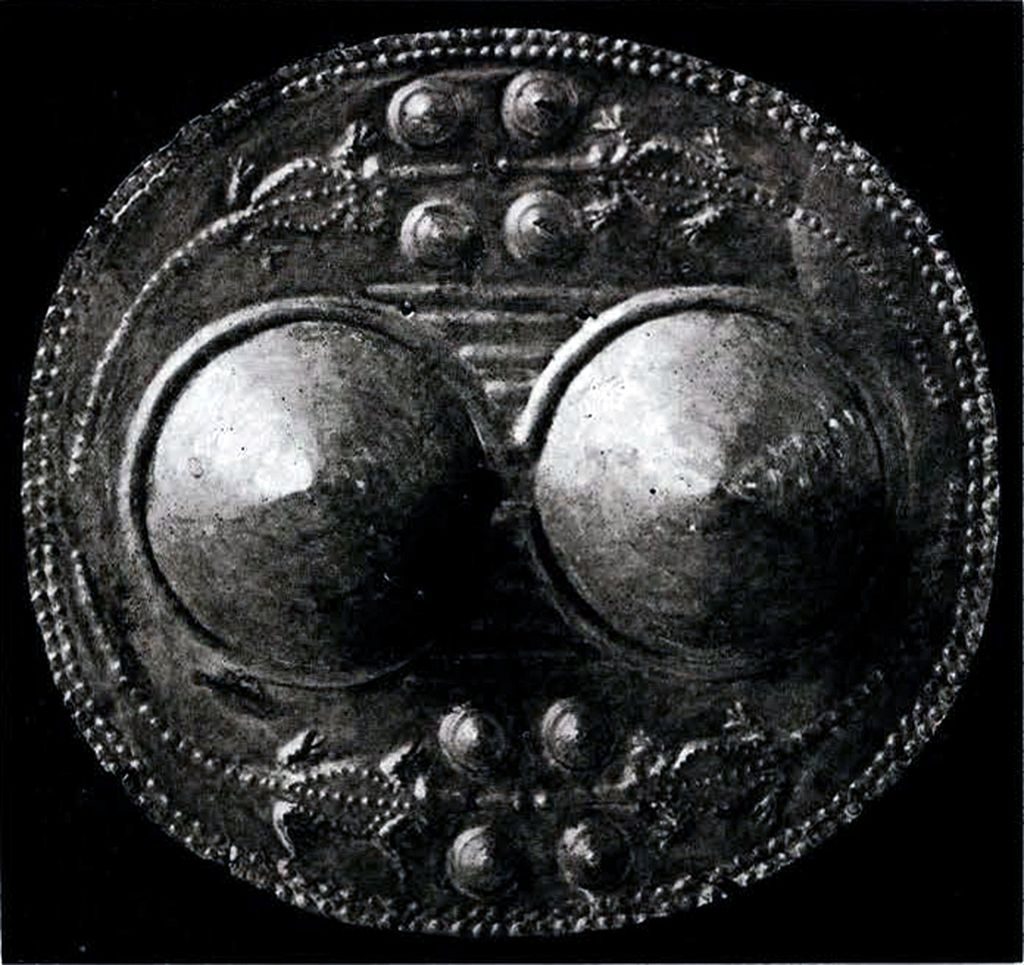
Museum Object Number: SA2705
Image Number: 20303
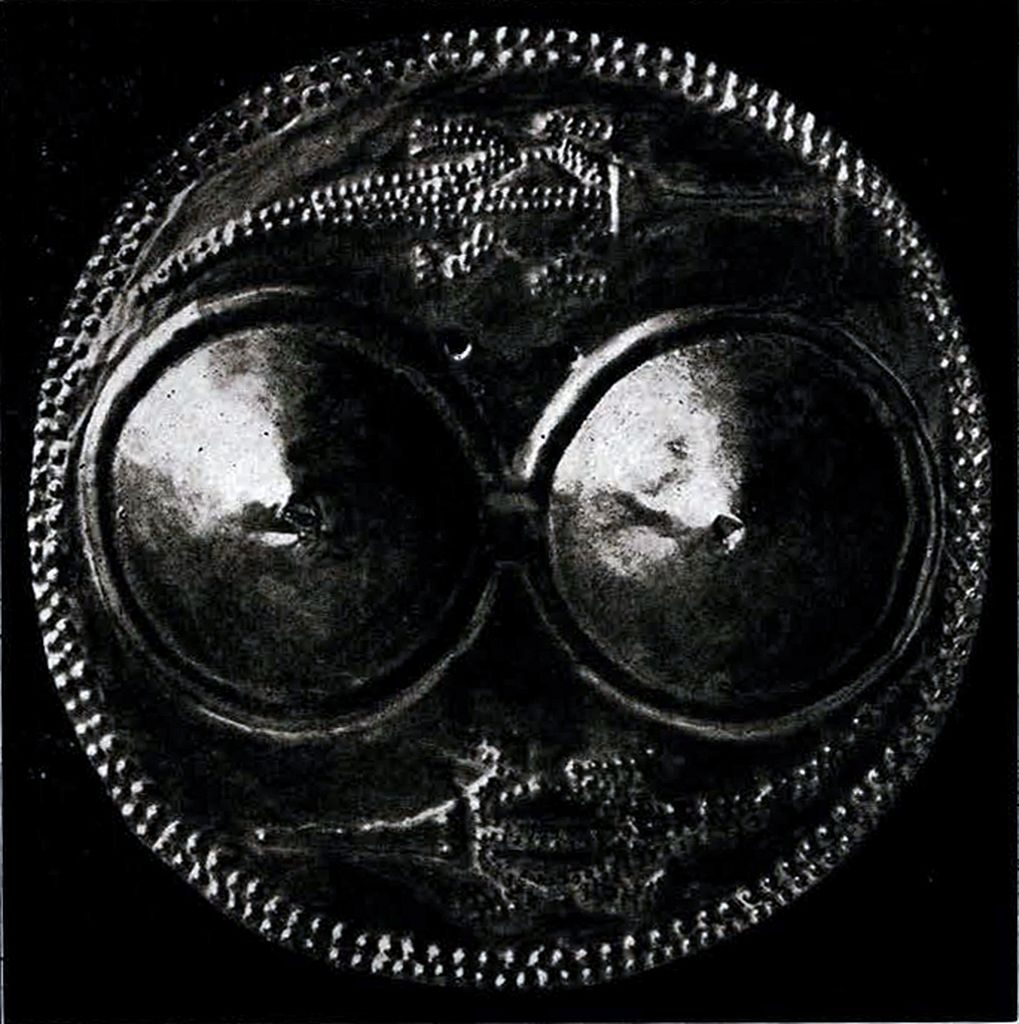
Museum Object Number: SA2704
Image Number: 20300
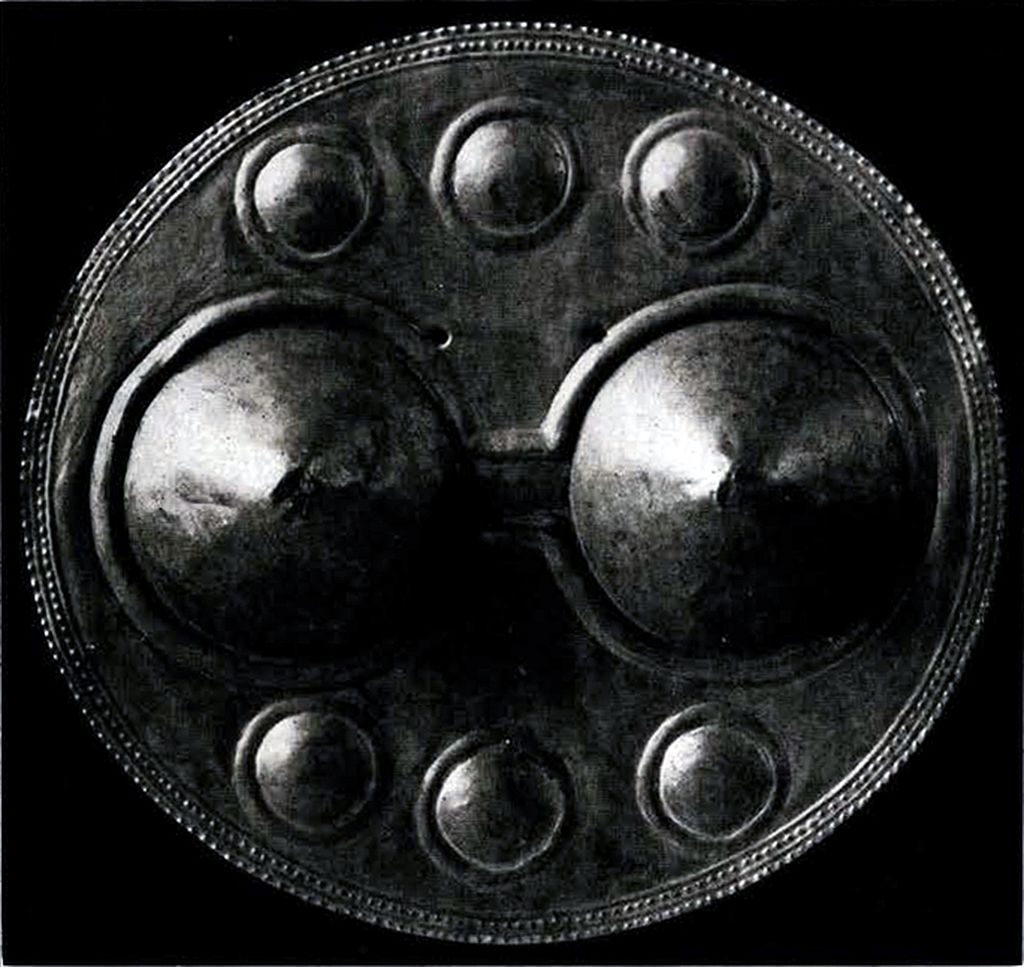
Museum Object Number: SA2706
Image Number: 20304
The great fortune in gold and emeralds from the Zita’s palace at Muequeta was never found. It, no doubt, was deposited in the sacred lake. The chiefs had learned from the experience of others that any attempt to purchase favor only led to further difficulty and that it was safer to dispose of the gold secretly. The Spanish greed for gold soon became notorious everywhere. The experience of Hatney, the head Cuban chief, comes to mind. As the Spaniards entered Cuba, he told his chiefs that resistance was of no avail, that gold was the god of the Spaniards and wherever the god was the Spaniards were sure to come. So he collected all the gold and cast it into the sea. But the Spaniards came, captured the chief and condemned him to be burned at the stake. A priest begged him to accept Christianity and be baptized so that his soul might go to Paradise. The chief asked if Spaniards went there, and when the friar told him that only good ones went, he replied that the best of them were bad and he preferred to go elsewhere. The poor heathen was burned alive.
Quesada saw no immediate possibility of securing more gold and, realizing the necessity of reinforcements to hold the territory in possession, he decided to return to Spain. He left his brother in charge of the government, now located at the new city of Bogata, which he founded August 6, 1538. Quesada, upon his arrival, found beautiful plateaus and fertile valleys densely populated with a happy and contented people in an advanced stage of culture. He departed leaving behind confusion, terror, desolation and death. He found a free people and left a race of slaves. They and their territory were divided into encomiendas under a government so bad that the natives had diminished by 1610 to one in three hundred. By the beginning of the eighteenth century, the Chibcha language was no longer heard in the land of the tortured Zipa.
Gold was obtained locally from the stream beds and quartz lodes by certain tribes and exchanged with neighboring tribes for other necessities. There must have been considerable traffic in gold dust and even in gold objects as accounts are given of the markets “where people sell gold and near them are they who trade in jewels mounted in gold in the form of birds and animals.”
The quantity of the gold of which the objects are composed is very variable. In a few cases there is an alloy of silver but in most cases the alloy is copper. The quantity varies from almost pure gold to almost pure copper. The alloy may have been natural but there is no doubt that the workers added alloys to suit their taste and the requirements of the object in hand.
The workmanship surpassed even the number of the objects. From Mexico an account is given of “two birds made of thread and featherwork, having the quills of their wings and tail, their feet, eyes and ends of their beaks of gold, standing upon two reeds covered with gold which were raised on balls of feather work and gold embroidery, one white and other yellow.” A fish is described having alternate scales of gold and silver.
The technique is most interesting. In the simplest case a single gold nugget is hammered into the form of some desired object. Other nuggets may be hammered into plates or thin sheets and cut to suit the purpose. Many objects have the appearance of having been soldered but when they are broken they show a rough fracture with pitted granular surfaces which are characteristic of casting. It is evident that a model has been built up of some plastic substance such as wax or resin. The same process seems to have been in use from Mexico to Peru. It is known as “cire perdue” and is as follows: powdered charcoal was mixed with clay and molded into the desired form on which the ornaments were engraved. Prepared wax was then applied to the details of the designs. The whole was then covered with powdered charcoal and clay. A connection with the wax model was made by means of a rod of wax coated with clay. The whole thing was then fired, the melted wax allowed to escape and the gold poured into the resulting mold. It was necessary to break the mold to get the object and this accounts for the fact that no molds of any kind have ever been found in the whole region. By this method it was possible to cast the objects which have the appearance of fine wire or filigree work. Many objects which show intricate delicate work and appear to be soldered together are in reality cast.

Museum Object Numbers, From Top: SA2733A / SA2733B / SA2735
Image Number: 20307
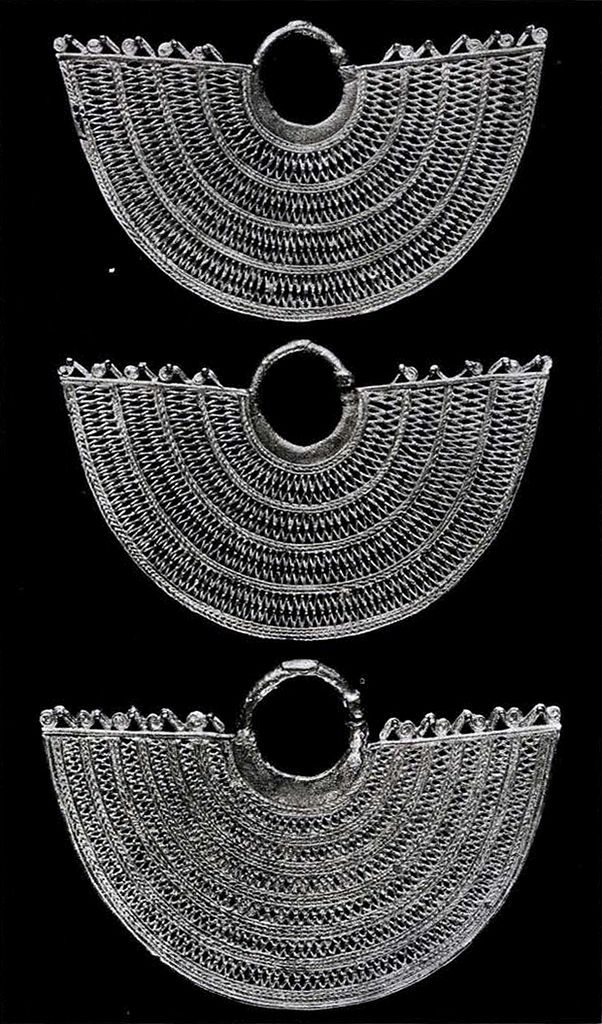
Museum Object Numbers, From Top: SA2732A / SA2732B / SA2734
Image Number: 20306
After casting, the objects were carefully polished on the exposed side. Men, anthropomorphs, monkeys and birds were constructed to present the frontal aspect to view while quadrupeds, reptiles, fishes and crustaceans present the dorsal view. A figure after casting was often modified by hammering as in the case of the flat feet of frogs and the wings of birds. Small objects were sometimes cast solid but all the larger ones were cast hollow with an opening at the back.
Important surfaces are carefully burnished. A specimen which contains a large amount of alloy may present a polished film on the surface of almost pure gold. This result is supposed to have been obtained by coating the object with the acid juices of a certain plant and then firing it. The gold is thus brought to the surface in a thin film. The question of gilding is an interesting one. The film of gold is often so thin that it resembles electroplating. Another method that may have been used was to coat the model with gold before it was put into the mold. When the mold was filled the gold would adhere to the surface of the object and after burnishing it would have the appearance of solid gold. The workers were very skilful also in overlaying wooden objects, as beads and throwing-sticks, with gold. They used gold inlays on wood and other metals.
Gold was used for most part as a useful metal; for decoration and ornament, but it was often associated with religious thought. According to the Inca belief, an egg of copper fell from heaven from which sprang the first Indians; after a time an egg of silver fell from which sprang the nobility; and after a longer period an egg of gold fell from which issued the Inca. Among the Chocos of Colombia, an important idol of gold was worshiped and slaves were sacrificed to it at certain seasons of the year. The idol represented a woman, who was once human and gave birth to a child who became the creator. She was deified after death, becoming mistress of thunder and lightning. The priests performed ceremonies before her to procure sunshine or rain when desired. Gods with human attributes are common everywhere and it may be supposed that many of the Central American anthropomorphs were worshiped as gods—the alligator god, the bird god and the crab god. Here the human attributes do not always constitute one of the elements in the composite gold image. An alligator body may have a bird’s head. Evidently animal forms played an important part in the native mythology and religion.
The objects in the collection here represented cover the whole field of suggested uses. Some of them are, no doubt, the direct representation of the god in human form; some are animal gods; some are coverings or ornaments of idols; some are personal amulets; some show rank of wearer and others are personal decorations and ornaments. We have historic references for all these uses but in any particular case it is impossible to be sure of our ground because these objects have been obtained from ancient graves. In considering the collections it will be observed that the utilitarian element is negligible, that practically all these objects were made for personal embellishment or religious symbolism. Even the personal ornaments appear to have a religious significance.
Catalogue of Gold Collections
A. From Antioquia, Columbia.
Three breastplates of thin beaten gold twenty-two inches across, decorated in repoussé around the borders and across the body, having two lateral bosses, perfect cones, six inches in diameter and four inches high. The remaining plain surfaces are relieved by twelve or fifteen smaller bosses. One of the plates has between the lateral bosses and the upper corners, in repoussé, a very realistic jaguar attacking an anaconda.
Five circular breastplates of beaten gold from ten to thirteen inches in diameter with lateral bosses four inches in diameter and three inches high. The largest one has, in repoussé, two crocodiles meeting at the top and two at the bottom. One has single crocodiles at top and bottom while the three others have bosses instead of animals.
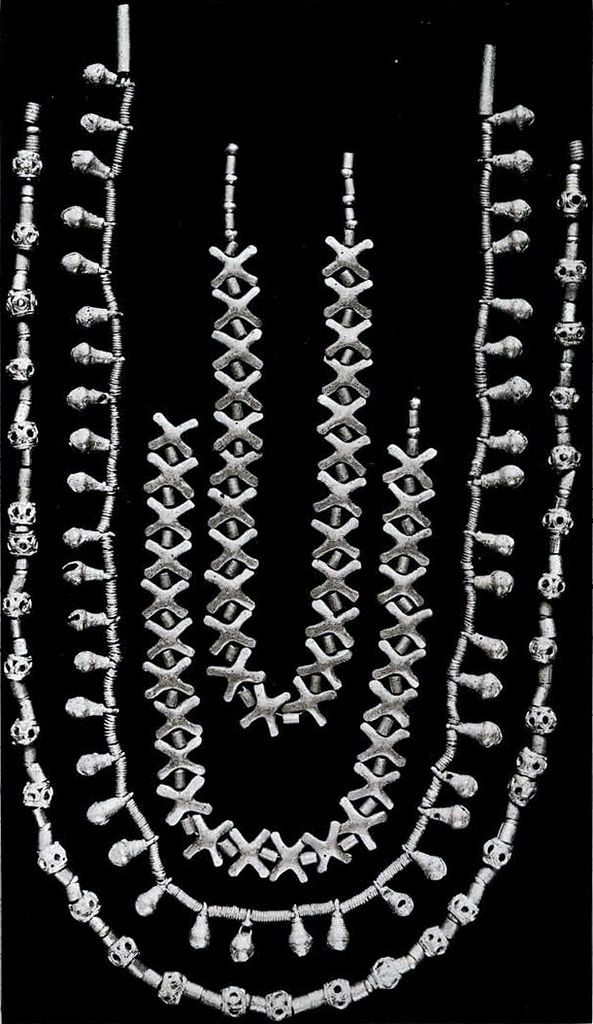
Museum Object Numbers, From Outermost: SA2743 / SA2742 / SA2737 / SA2736
Image Number: 20310
A girdle three feet long and seven inches wide, made up of one hundred and thirty-eight solid gold bars each four inches long and tapering from one-eighth to three-eighths inches in width. The bars are arranged in two bands on three cords strung between gold beads.
Eight fan-shaped nose-rings cast in solid gold, four and a half inches wide and two inches high, made in finest wire filigree work and decorated along the top with birds’ heads. Two show a large per cent of silver alloy.
Six solid staff heads; two are of large birds, one of two birds, one a jaguar whose spots are shown as holes into his hollow body, two are of monkeys wearing hats, seated on four-legged chairs with high backs, holding bowls to their lips. They remind one of the mummies of the Incas seated in chairs around the temple walls.
Four bells in form of handbells two inches high and one in diameter with opening along the side. Three are gold and decorated, one in form of the owl woman. One is copper.
Sixteen solid gold nose or ear ornaments of various sizes from a half to an inch and a half across. The ends are expanded into flat discs.
Nine strings of gold beads; one of forty-one very small bells with fine coiled wire beads between, one of twenty-six bells, one of sixteen larger bells with cylindrical beads between, one of thirty-three filigree beads with plain ones between, one of a hundred and thirty-five very small cylindrical beads and two of twenty-four star-shaped beads each.
Eight plain bracelets made of a solid gold rod, one-eighth inch in diameter.
Ten gold nose ornaments; eight solid rings and two discs.
Twelve discs or bosses of plain gold.
One funnel-shaped ornament three inches high and two and a half in diameter.
Gold arm band three inches broad embossed at both ends. Helmet of plain gold, in fragments.
Six sheets of very thin beaten gold about sixteen by twenty inches in size, two with repousséd borders. All have perforations across the ends for attachment to garments, house-walls or altars.
B. The Paris Collection.
Two female images of pure gold, similar in size, ornamentation and technique; hollow cast, nine inches high, shoulder breadth three inches, hip breadth two and three-quarter inches and depth one inch; each image wears necklace, leg and arm bands, nose rings, earrings and crown. The hands extend forward bearing flowers. They are beautiful specimens and real works of art. Quimbaya.
Two gold discs seven and a half inches in diameter, decorated in repoussé with human face and sun’s rays beneath. One plain disc five inches in diameter.
Four great undecorated cuffs, of heavy beaten gold, one pair nine inches long and the other seven, tapering from four inches in diameter at the top to two and a half at the wrist.
Six gold crowns from one to four inches in width, two with large birds standing up in front.
Two symbolic figures seven inches high and four and a half wide, with human-like face and curious winged body ending in a crescent, cast one-eighth inch thick. Chibcha.
A bronze knife or razor five and a half inches long, having a serpent crawling along the top of the blade and a beautiful solid gold stork standing on the end of the handle. It is one of the most interesting specimens.

Museum Object Number: SA2715
Eighteen personal charms or amulets in the form of animals, birds, crustacea and anthropomorphs. The best one is a bell monkey three inches high sitting in a swing of twisted gold rope which ends in serpents’ heads. There are three birds, one large flat and the others only one-half inch long; two alligators, one crab, one spider, one eagle, one puma, one flat manlike animal, two frogs and four dogs. Central America.
Five ear ornaments, one pair one and a half inches in diameter with double bird designs in repoussé.
Fourteen nose ornaments; two bars, five rings and seven discs. One coiled serpent.
Seven figures of men from two to three inches high. The best one is holding aloft at arm’s length a serpent whose head and tail form a part of his headdress. There are also two solid cast silver men.
Three models of throwing sticks and five pins from four to six inches in length cast in solid gold. One of the sticks shows two finger holes at the base and on the top an eagle whose beak serves for the knob. Another shows the knob lashed on with very fine gold wire. Most interesting ethnological specimens. Three of the pins have birds standing on top. Chibcha.
Three peculiar ornaments six inches long covered with numerous discs and bird-like bangles. One flat key-pad with eight hooks. Chibcha.
Two hollow bracelets three-quarters of an inch in diameter, with the ends fitting together and the edges joined along the inside but not soldered. Very difficult to manufacture.
A fragment of an image representing the mask of a human face, with inlaid headband, eyes and teeth. At each corner of the mouth a turquoise is set representing four teeth. Mexico.
Fourteen hollow gold beads, eight capped cylinders soldered along the joined edges, each having four human faces in repoussé; six ovoid beads with human faces on each side, made in halves and soldered together. Peru.
C. Inca Gold and Silver.
A death mask of thin beaten gold six by eight and a half inches, features in repoussé with diamond-shaped eyes and projecting nose.
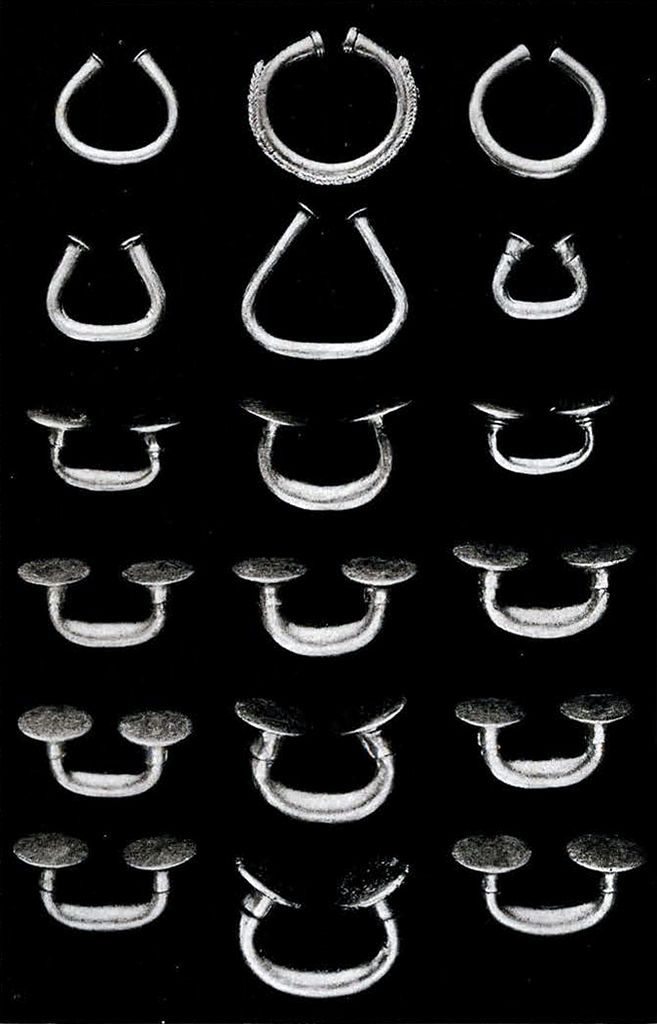
Museum Object Numbers: SA2721.1 – .17
Image Number: 20308
Three gold bells; one, the most perfect of all the bells, is a man with dog’s head sitting in a swing on the edge of the flat topped bell and holding a double-headed serpent in his mouth; another is a grotesque animal sitting in a hoop of coiled wire which ends in loops on the tops of his ears and the third is a beautiful bell in the form of a very small owl.
Two gold men; one an inch and a quarter high with spiked headdress and the other two and a half inches high, wearing a double wire snake belt and holding snakes’ heads in his hands.
Three pairs of gold tweezers, one pair three inches long and the others one inch.
One gold cuff five by seven inches with incised decoration at the top and bottom, two beads and one gold leaf worked in lines and dots.
A gold-headed pencil and three bronze pins.
A perfect silver idol nine inches high, hollow cast, in female form, sharply defined features with high Roman nose, hair parted in the middle and hanging down the back where it is caught with a silver ornament.
Five idols cast in solid silver in male form about three inches high: one has a rattlesnake hanging around his neck, one wears a headdress, girdle, arm and leg bands and carries an image of the sun and a staff of office, one has a duck sitting in his open hand, one wears a bird headdress and carries two large ears of corn as an offering and the last has a double body. There is also a silver deer and a wooden monkey.
A silver plate, three by three and a half inches, bearing an incised design of a conventionalized human form with an animal head and carrying in his hand a wand with a jaguar’s head.
D. Central American Gold.
Three conventionalized gold men; one three inches high standing on the edge of a broad flat pedestal with upturned ends and wearing a headdress like the pedestal but inverted, another two inches high of the same pattern and the third is plain and two inches high.
Three gold bells one inch in diameter and an inch and a half high.
Seven gold frogs; two holding four snakes’ heads each in their mouths two small ones of common type and three large ones three by three and a half inches in size carrying snakes in their mouths.
Four gold birds with flat tails and wings, three by two and a half inches in size.
Eleven gold discs from four to six inches in diameter, decorated in lines and repoussé.
E. Aztec Gold.
Two filigree rings of gold, one small with little decoration but the other represents the very height of the goldsmith’s art. The design shows a man in profile seated in a framework wearing an elaborate headdress and other decorations.
Ten small gold bells, eight of the sleighbell type, one has an animal sitting on top of the bell and one cast in the form of two joined hands with filigree cuffs.
Two men cast in solid gold, one with large quadrangular headdress is holding out in front of him a small animal in each hand, the other is standing with one hand raised.
A very realistic hollow cast turtle of low grade ore.
A hollow cast eagle’s head lip plug one and a half inches long.
F. Aztec Precious Stones.
Among the Aztecs, jade, crystal and jet were as highly prized as gold, silver and copper. The bright green jade was considered so precious that its use was restricted to those only of high rank. Beads and necklaces of jade were collected from certain tribes of Indians as tribute money. In the production of the finer works of art in jade and crystal, points of flint and copper were utilized for graving and drilling. When the cutting was completed emery was employed in rubbing and polishing the surfaces. It is said that Montezuma sent beautiful specimens of crystal and jade by Cortes for the personal use of the Emperor.
Two necklaces of gold and highly polished green jade beads.
One decorated jade bead five inches long by one-half wide and one-quarter, drilled lengthwise.
One jade ear ornament, two birds’ heads, six carved heads with headdresses and one elaborately carved human figure of bright green jade seated in a panel with face in profile wearing a large headdress, ear and neck ornaments and a girdle. All are perforated for suspension.
Six jade squatting human figures from one and a half to three and a half inches high. Perforated for suspension.
One death’s head, one cylindrical bead and one lip plug all of perfect crystal.
Six jet lip plugs.

